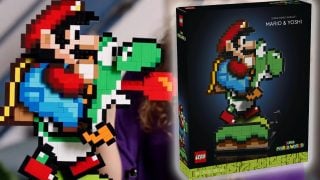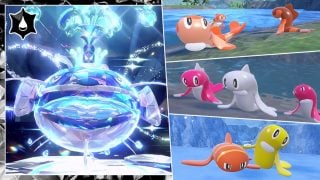Beauty in games is something that I feel is often underappreciated. And I’m not speaking of graphical fidelity or how detailed the grass physics are – I mean true beauty, the kind that speaks to something deeper. How, with a single image, a single song, a single line of dialogue, you’re whisked away to a land far from your own in an instant, and make you look at the world you live in with fresh eyes and a new heart.
I can say, with utmost certainty, that Ōkami is the most beautiful game I have ever played.
Today, September 19th, marks the tenth anniversary of its release in North America, and there’s no better way to honor it than to reflect upon its legacy – which has left its mark upon me and many others, even a decade later.
A land of myths and gods
The title “Ōkami” comes from a Japanese pun and homonym – 大神 means “great god”, while 狼 translates to “wolf.” This provides the crux of the game’s concept: the player takes control of the Japanese sun goddess Amaterasu in the form of a white wolf, as she walks the land to rid it of evil and restore faith in the gods. Journeying with her tiny not-bug companion Issun, Amaterasu travels throughout all of Nippon, doing battle with demons, assisting needy people, and bringing life back to the land with her divine grace.
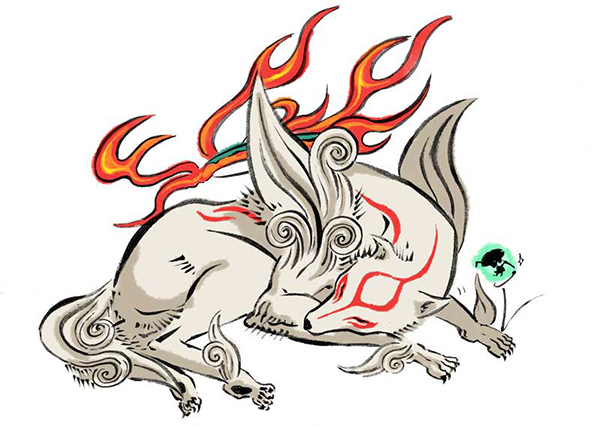
While the game does start off a bit exposition heavy, with the recounting of the slaying of Orochi by Amaterasu’s previous incarnation Shiranui and the warrior Nagi, it does an excellent job setting up the tone, atmosphere, and stakes of Amaterasu’s quest. In a land rich with references to Japanese mythology and mystical medieval creatures, the goddess is up against extremely difficult odds – most of her powers have been lost due to a decline in faith, the darkness of Orochi’s return has corrupted the land itself, and without the aid of the wood sprite Sakuya the land would almost surely perish. Despite the fact that the player controls a literal god, they feel the overwhelming odds stacked against them. It’s not the usual sort of “god game” – Ammy is fighting to take back her world and her powers, and every step of the way is fraught with tension.
As mentioned, Ōkami is filled with an immense number of allusions to Japanese mythology – nearly every character, place or item holds some reference to tales of old, but they aren’t constrained by these references either. The team at Clover Studio took great creative liberty with their interpretation and utilization of some myths, but the game is all the greater for its flexibility. The way characters from various legends interact and mingle with the beautiful world allows for mystique, wonder, and even a bit of futuristic technology in the setting. It’s one of the most unique game worlds ever created, in no small part because it’s focused more on creativity than accuracy.
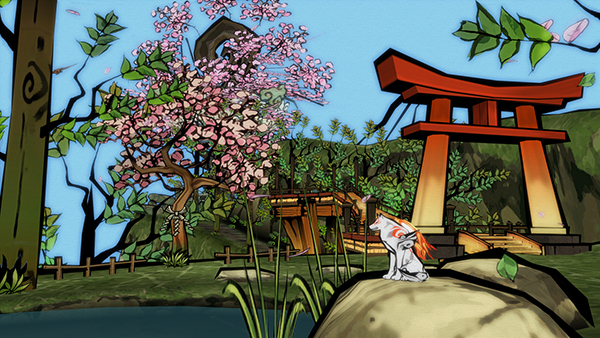
The characters inhabiting the world are also nothing short of fantastic. From amazing supporting characters like the boisterous Susano to the fruity Waka, to wacky NPCs such as Mr. Orange, to countless others – Ōkami is a game rich in characters and places to interact with. Almost everything and everyone you encounter – including an electric ghost, a possessed scrap of paper, and a dopey sleeping bear – is either entertaining, interesting, or otherwise memorable. And the villains also inspire dread and fear, especially since many are also based on Japanese folklore.
But if there’s one aspect of Ōkami’s story that I love, it’s how the game truly feels like an epic. When you read very old stories of heroes, such as Beowulf or the Epic of Gilgamesh, the protagonists often go through multiple arcs or stages in life. So it is too in Ōkami – Amaterasu does not merely contend with Orochi throughout her journey, but also with a slew of other demons and problems that afflict Nippon, both adding to the sense of acting as a god and establishing a greater sense of scope. There are very few games which truly feel like an epic poem from start to finish in terms of style and execution, but Ōkami is perhaps the most effective at it.
Heavenly aesthetic
I’ve always preferred style over detail when it comes to graphics, and there is perhaps no finer example of that than Ōkami. Originally released in the months before the PS3’s release, when the PS2 was beginning to show its age and limits, Ōkami provides one of the greatest video game aesthetics of all time. The entire game holds the appearance of a Japanese ink painting infused with color, creating rich, vibrant environments and characters that are more evocative of an indie title than a AAA game – but it’s all the better for it.
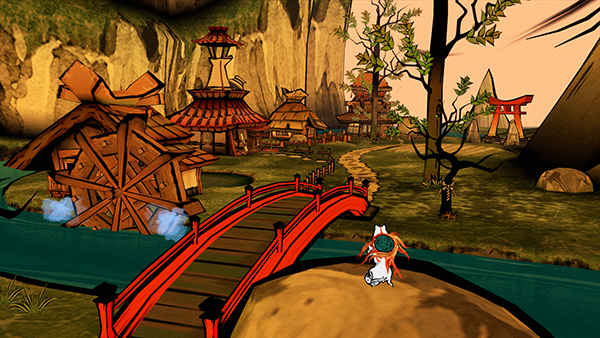
Not content to revel in its style, the designs are magnificent. Characters are distinct, environments are atmospheric, and enemies are grotesque – a perfect match of style and design that evokes the exact meaning intended. The scenes of restoring the land through Guardian Saplings are beyond breathtaking, accompanied by triumphant music and wide, sweeping vista shots that drive home the extent of your powers. And special mention must go to Ammy’s character design, which might be my favorite of any, ever- the red lines, flaming mirror, and regal build are as iconic as they come, and I jump at the chance to buy nearly anything with her figure emblazoned on it.
And we haven’t even gotten to the music – dear Amaterasu, the music! Ōkami has my favorite game soundtrack of all time, which, considering my love of game music in general, is quite a feat. Like the artstyle, the instruments and composition are evocative of ancient Japanese styled music, and the entire five+ hour soundtrack is endlessly listenable. Every piece fits the area and time in which it’s played beautifully, and once again the variety in tone and feeling is immense for the range of style it fits in.
Picking a favorite track is literally impossible; there are too many excellent ones to count. “Shinshu Field,” “Ryoshima Coast,” “Descent of the Great Goddess”… the themes of Issun, Susano, Waka, Kushi, Sakuya, Kaguya, Oki, and so many more… the huge variety of boss music… and endless more than are pure, elegant mastery. If I had to pick two that stood out above the rest, I would have to go with “Reset ~Thank You Version~” and “The Sun Rises,” both of which play in the game’s final hour, and by themselves inspire feelings and emotions that I am physically incapable of putting into words. The songs by themselves are works of art – and combined with the game itself, provide a massively rich experience all on their own.
Brush and blade
Now for the meat: the gameplay. Ōkami is, in short, a Zelda-style action-adventure game, complete with dungeon exploration, puzzle solving, side quest taking, and a multitude of items/abilities that allow you to access new locations and things. But what sets Ōkami apart is not only in how well it executes these various aspects, but how it improves upon the genre as a whole. And the core of how it does so lies in the game’s main mechanic – the Celestial Brush.
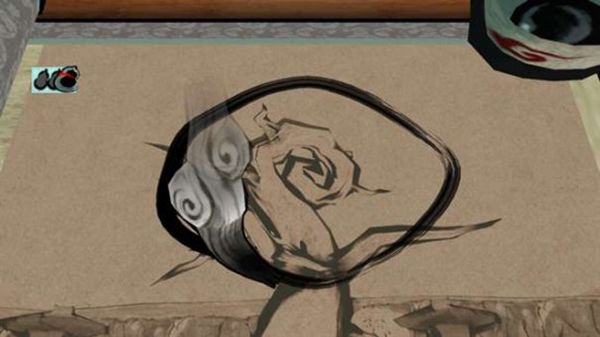
The Celestial Brush allows the player to stop the action for a moment in order to draw lines of ink upon the screen, which can have a variety of effect. There are the simple implements, such as the single-stroke Power Slash that hurts foes, or the several abilities that allow you to transfer elements (water, fire, lightning, etc.) to another location. And then there are the more creative ones – slowing down time, changing the time of day, creating lily pads to cross in the water and more. Some of these abilities could even be upgraded after accomplishing certain tasks, allowing you to summon infernos or thunderbolts with a few strokes of the Wii Remote or a few movements of the Dualshock stick.
The implementation of the Celestial Brush system is nothing short of genius. It gets rid of inventory clutter, it’s balanced by the use of ink bottles, and it allows for truly creative and inventive puzzle solving. Sure, it was a bit finicky with regards to certain shapes, but it’s still incredibly impressive how versatile and convenient the system as a whole is. Not to mention, it plays with and outright enhances the ink painting style the game is built on, creating a beautiful integration of gameplay and style that is exceedingly rare outside of the indie community.
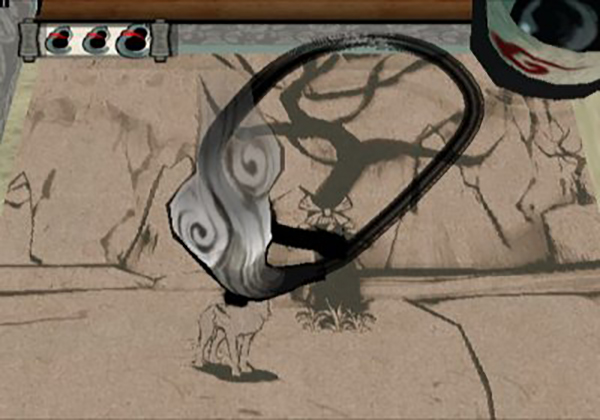
Combat itself is immensely fun, too. Amaterasu has three main weapon types to choose from: mirrors, beads and glaives (a reference to the Imperial Regalia of Japan), which can be set as either main weapons or sub weapons. Mirrors are middle of the road when it comes to speed and strength, and can deflect projectiles; beads are fast and multi-hit, but weak, and can also be used as a ranged tool; glaives are slow but strong, and can be used with a special charge attack. Everybody can find a combination that suits their playstyle, and all three weapon types are fun to use.
When used in conjunction with the Celestial Brush, fights become varied and interesting, especially due to the way enemies are often puzzles of their own. You have to use the correct technique in order to weaken them sufficiently, and then you can pummel them; otherwise, most of the time, your attacks will be ineffectual or downright worthless. Figuring out how to defeat certain enemies is intuitive and never particularly difficult, but it is a ton of fun to do so. Not to mention, the game’s ranking system encourages you to master your skills in order to achieve a perfect score for both time and damage.
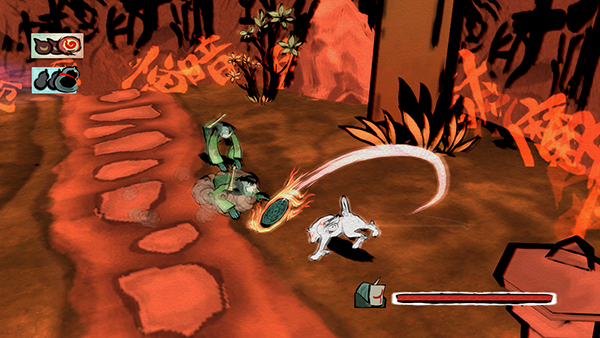
Celestial Brush techniques are also a staple of exploring the rich and grand environments of Nippon, and the number of ways in which they’re used must once again be commended. Players must use every tool in their kit, along with timing, patience and art expertise in order to solve some of the puzzles and find some of the collectibles the game has to offer. While 100%ing the game can be a bit painful (How many animals must be fed? How many stray beads must be found? It feels like the answer to both is infinity), there’s always a dearth of things to find in the world, and it’s supplemented nicely by the occasional minigame or two… though some are a tad obtuse. Lookin’ at you, digging for water sequences.
The dungeons are also very well designed, and the bosses are fantastic, though they tend to follow the old Zelda rule of “use the item/ability you learned here to beat them.” Even so, their scale and design makes every one distinct and memorable, two in particular – the battle against Orochi, where you have to get all his heads drunk before you can attack the bell on his back, and the fight against Ninetails, where you duel against a beast that it nearly your equal in terms of power and skill. To say nothing of the final boss, which is a long, grueling battle that will test every skill you’ve mastered on the journey… not to mention your emotional resilience, considering how powerful the scenes around the battle are. While I don’t want to delve too much into the topic due to spoilers, the last hour or two of the game is one of my favorites in the entire medium, and still sends chills up my spine whenever I think of it to this day.
Legacy of light
To describe Ōkami in words does it almost no justice. Like all gaming masterpieces, it’s meant to be played, not described. I can sit here for hours gushing about its style, or its world, or any of the other aspects that are wonderfully done. But in the end, it will do almost nothing compared to actually playing the game itself.
Ōkami did what was almost unthinkable. It took the gameplay of Zelda – perhaps the most revered and respected franchise of all time – and made it better. It fully immersed itself in a world of spectacular art and wondrous imagination. It built upon its roots in Japanese mythology to craft an immensely unique and fantastic story all on its own. And it did all that with such grace and poise that it’s endured past terrible early sales to establish a name and legacy that will far surpass many other games.
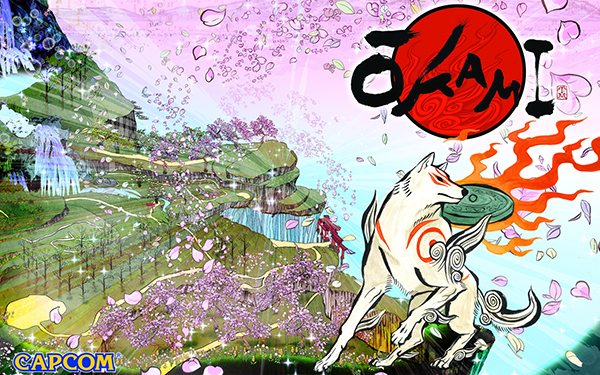
Ōkami is the most beautiful game I’ve ever played. And it’s not merely the package as a whole that’s beautiful. The graphics, the music,the characters, the world, the mechanics – all are pieces of art in their own right, carefully woven together to form a masterful canvas that few can compare to. It may not be the most influential game, nor the best selling, nor one that will make many Top 10 All-Time Greatest Lists, simply due to its place in history and time.
Yet all great art endures, and I know that this is a game that will be played for many years to come. Just as the sun always rises upon a new day, so too will this game always be there, a staunch reminder what what you can do in the medium of video games.
Leave a Comment